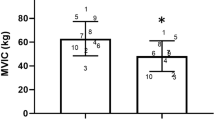Abstract.
This study examined the force production characteristics, activation/coactivation and endurance capacity of the neck extension and flexion muscles in healthy men (n=29) and women (n=28) divided into three age groups (18–26 years, 30–37 years and 45–55 years). Force and electromyography (EMG) measurements were performed during the maximal voluntary isometric extension and flexion actions. This was followed by an endurance test (ET; 60% force level of maximal voluntary contraction sustained until exhaustion), after which the force and EMG recordings were repeated. Men were both stronger and had higher values (P<0.001) for explosive force (rate of force development, RFD) than women in both actions. Younger subjects of both genders exhibited larger (P<0.05 in women) RFD values than older subjects in extension. The coactivation of the antagonist muscles during the maximal extension or flexion did not differ significantly between men and women, but the coactivation of the antagonists was larger (P<0.05) in the older age groups than in the youngest group. Women maintained the 60% force level longer than men in both actions (extension, P<0.001; flexion, not significant). The fatiguing loading led to significant decreases in maximal isometric force (P<0.001) and RFD (P<0.01–0.001), but these relative decreases did not differ between the groups. In conclusion, large gender differences in the voluntary extension and flexion force production characteristics of the neck muscles did exist, as reported earlier for other muscles of the body. No age-related differences were observed in maximal force of the extension and flexion actions within the age ranges of the subject groups studied here, but the older subjects exhibited greater coactivation and produced lower force values in the early portions of the force/time curve of the extension than the youngest group. The data indicate that explosive force production may be sensitive to aging earlier than maximal strength in the case of the neck extensor muscles.
Similar content being viewed by others
Author information
Authors and Affiliations
Additional information
Electronic Publication
Rights and permissions
About this article
Cite this article
Valkeinen, H., Ylinen, J., Mälkiä, E. et al. Maximal force, force/time and activation/coactivation characteristics of the neck muscles in extension and flexion in healthy men and women at different ages. Eur J Appl Physiol 88, 247–254 (2002). https://doi.org/10.1007/s00421-002-0709-y
Accepted:
Issue Date:
DOI: https://doi.org/10.1007/s00421-002-0709-y




